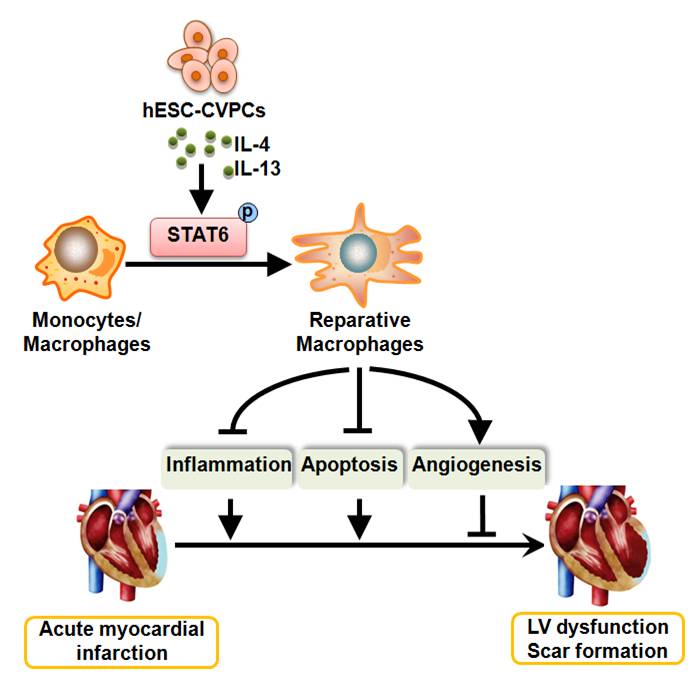hESC-CVPCs Repair Infarcted Hearts Through Modulation of Macrophages via Activation of STAT6
Myocardial infarction (MI) is the leading cause of morbidity and mortality worldwide. Cell-based therapies are being explored as a therapeutic option for patients with MI. Human Embryonic Stem Cell-Derived Cardiovascular Progenitor Cells (hESC-CVPCs) hold a great promise for the myocardial repair of MI. However, it remains largely unknown about the mechanisms underlying their beneficial effects on infarct healing. Inflammatory cascade occurring during the early phase of MI acts as a driver for exacerbating and healing scar formation. It is unclear whether hESC-CVPCs modulate the inflammatory response when implanted at early phase of MI and whether such effect contributes to the cardiac repair.
To address these issues, researchers at Shanghai Institute of Nutrition and Health of Chinese Academy of Sciences, investigated whether hESC-CVPCs delivery into acutely infarcted hearts repairs damaged hearts through modulation of macrophage subpopulations.
The researchers found that transplantation of hESC-CVPCs into the murine MI hearts significantly ameliorated the heart function and scar formation, reduced inflammatory reactions and cardiomyocyte apoptosis as well as increased vascularization. Moreover, hESC-CVPCs modulated cardiac macrophages towards a reparative phenotype. This modulation was dependent on their secreted cytokines, such as IL-4 and IL-13, via activating signal transducer and activator of transcription 6 (STAT6). Furthermore, STAT6 knockout exacerbated infarct injury and cancelled the cardioprotection in the modulation of macrophage polarization, amelioration of cardiac function and reduction of scar area afforded by hESC-CVPCs in the murine infarct hearts, though these mice had normal cardiac performance.
These findings reveal previously unrecognized immunoregulatory roles of hESC-CVPCs on the macrophage polarization in the infarcted hearts, its importance for the infarct repair, and the underlying signaling pathway. The findings provide new insight into the mechanism of micro-environmental regulation of stem cell-based therapy during acute MI.
This work was completed by a research team led by Prof. YANG Huang-Tian, at the CAS Key Laboratory of Tissue Microenvironment and Tumor, Shanghai Institute of Nutrition and Health, Chinese Academy of Sciences. The results entitled “Human Embryonic Stem Cell-Derived Cardiovascular Progenitor Cells Repair Infarcted Hearts through Modulation of Macrophages via Activation of STAT6” was published online in Antioxidants Redox Signaling on Mar 11th, 2019. (https://doi.org/10.1089/ars.2018.7688)
The research was supported by grants from the National Key R&D Program of China, the Strategic Priority Research Program of the Chinese Academy of Sciences, and National Natural Science Foundation of China. This research also got supports from cooperators Prof. WANG Yigang of University of Cincinnati and Prof. Eugene CHIN of Soochow University.

A proposed model for the cardioprotection of hESC-CVPCs in the mice model of MI.
(Image by Prof. YANG Huang-Tian's Group)
Media Contact:
WANG Jin (Ms.)
Shanghai Institute of Nutrition and Health,
Chinese Academy of Sciences
Email: sibssc@sibs.ac.cn
